NVIDIA nForce 500: Biostar and MSI Aim for the Gold
by Gary Key on June 8, 2006 4:30 AM EST- Posted in
- Motherboards
MSI K9N SLI Platinum: Board Layout
MSI provided an excellent board layout with all major connections easily reached. There were no clearance issues and the MSI was very easy to install in a mid-size ATX case. The board is a mainstream design with a 3-phase voltage regulator. However, MSI used very good quality capacitors that yielded excellent stability and good overclocking results.
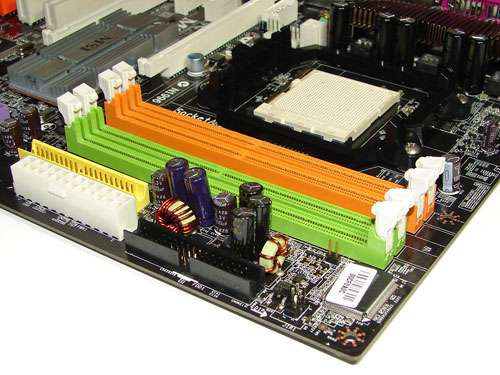
The DIMM module slots' color coordination is not correct for dual channel setup based upon the premise of utilizing the same colors for each memory bank. In other words, you will need to install one DIMM in an orange slot and one in a green slot for dual channel operation. The memory modules are slightly difficult to install with a full size video card placed in the first PCI Express X16 slot. The single NVIDIA IDE port connector is color coded yellow and located behind the 24-pin ATX power connector. The floppy drive connector is color coded black while being positioned along the upper board edge and below the memory slots.

The six NVIDIA SATA ports are color coded purple and are conveniently located below the NVIDIA MCP. The SATA ports feature the newer clamp and latch design. We found the positioning of the SATA ports to be very good when utilizing our 7900 GTX SLI configuration. The NVIDIA MCP is passively cooled and based upon our thermal tests we would have recommended an active cooling fan similar to the one Biostar installed. Although we did not notice any ill side effects from the passive cooling the heatsink was extremely hot after gaming for a few hours or running our benchmark tests.
The chassis panel is located at the bottom edge of the board along with the two USB 2.0 headers and IEEE-1394a header. The BIOS chip and battery are located between the USB headers and SATA connectors. MSI continues to offer a clear CMOS button that is located above the BIOS chip and color coded red. If required, the operation of the button is immensely easier than the traditional jumper design.
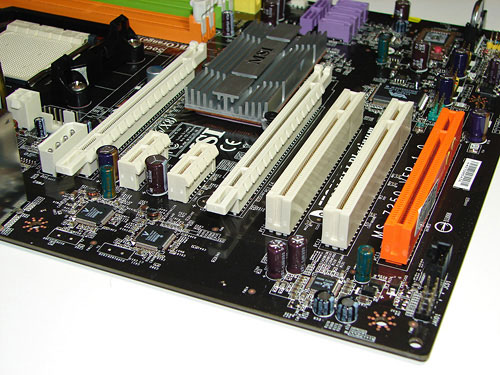
The board comes with (2) physical PCI Express X16 connectors, (2) PCI Express X1 connectors, and (3) PCI 2.3 connectors. The layout of this design offers an exceptional balance of expansion slots for a performance oriented board while providing very good clearance space for card utilization.
The first PCI Express X16 connector is located to the far left of the slot areas. The first PCI Express X1 connector is located next, followed by the second PCI Express X1 connector, the second PCI Express X16 connector, and then the (3) PCI slots. Although there are two physical X16 connectors available on the board, they operate in X8 PCI-E mode in multi-GPU or SLI mode.
We did not have any issues installing our EVGA 7900 GTX 512MB video cards in the first or second X16 PCI Express slots. A dual slot card located in the first X16 connector will physically render the first PCI Express X1 slot useless while a dual slot card in the second X16 connector will physically disable the first PCI 2.3 slot. There were no issues utilizing either slot with video cards containing single slot cooling systems.
The CPU socket area had plenty of room for our Zalman CNPS9500 AM2 cooler. There should also be plenty of room for alternative cooling solutions. Units similar in size to the Zalman or even larger size cooling solutions should fit in this area without issue.
MSI places the four-pin 12v auxiliary power connector at the top left are of the CPU socket and out of the way of our cooling solutions. However, this connector is located in a position that can hamper airflow with cabling that crosses directly over the CPU heatsink/fan.
The four-pin Molex power connector is located to the right of the first X16 PCI-E connector and must be utilized for multi-GPU or SLI operation. This connector is located in a position that could hamper airflow with cabling that crosses directly over the CPU heatsink/fan. The CPU fan and Chassis fan headers are located between the two power connectors.
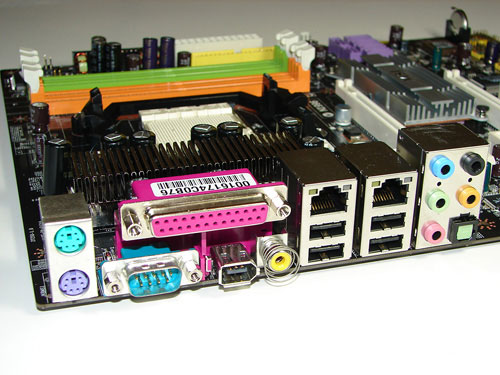
The rear panel contains the standard PS/2 mouse and keyboard ports, parallel port, dual LAN ports, and 4 USB ports. Each LAN (RJ-45) port has two LED indicators representing Activity and Speed of the connection. The audio panel consists of 5 ports that can be configured for 2, 4, 6, and 8-channel audio connections. The panel also consists of two S/PDIF (optical/coaxial) ports and an IEEE-1394a port.
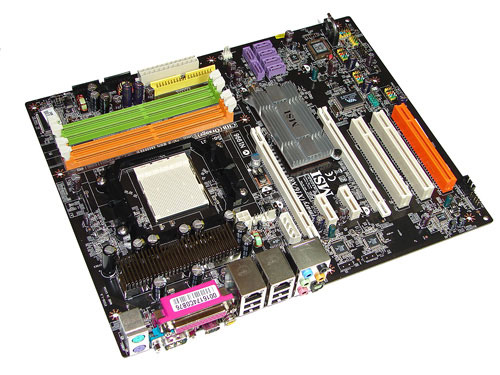 |
| Click to enlarge |
MSI provided an excellent board layout with all major connections easily reached. There were no clearance issues and the MSI was very easy to install in a mid-size ATX case. The board is a mainstream design with a 3-phase voltage regulator. However, MSI used very good quality capacitors that yielded excellent stability and good overclocking results.

The DIMM module slots' color coordination is not correct for dual channel setup based upon the premise of utilizing the same colors for each memory bank. In other words, you will need to install one DIMM in an orange slot and one in a green slot for dual channel operation. The memory modules are slightly difficult to install with a full size video card placed in the first PCI Express X16 slot. The single NVIDIA IDE port connector is color coded yellow and located behind the 24-pin ATX power connector. The floppy drive connector is color coded black while being positioned along the upper board edge and below the memory slots.

The six NVIDIA SATA ports are color coded purple and are conveniently located below the NVIDIA MCP. The SATA ports feature the newer clamp and latch design. We found the positioning of the SATA ports to be very good when utilizing our 7900 GTX SLI configuration. The NVIDIA MCP is passively cooled and based upon our thermal tests we would have recommended an active cooling fan similar to the one Biostar installed. Although we did not notice any ill side effects from the passive cooling the heatsink was extremely hot after gaming for a few hours or running our benchmark tests.
The chassis panel is located at the bottom edge of the board along with the two USB 2.0 headers and IEEE-1394a header. The BIOS chip and battery are located between the USB headers and SATA connectors. MSI continues to offer a clear CMOS button that is located above the BIOS chip and color coded red. If required, the operation of the button is immensely easier than the traditional jumper design.

The board comes with (2) physical PCI Express X16 connectors, (2) PCI Express X1 connectors, and (3) PCI 2.3 connectors. The layout of this design offers an exceptional balance of expansion slots for a performance oriented board while providing very good clearance space for card utilization.
The first PCI Express X16 connector is located to the far left of the slot areas. The first PCI Express X1 connector is located next, followed by the second PCI Express X1 connector, the second PCI Express X16 connector, and then the (3) PCI slots. Although there are two physical X16 connectors available on the board, they operate in X8 PCI-E mode in multi-GPU or SLI mode.
We did not have any issues installing our EVGA 7900 GTX 512MB video cards in the first or second X16 PCI Express slots. A dual slot card located in the first X16 connector will physically render the first PCI Express X1 slot useless while a dual slot card in the second X16 connector will physically disable the first PCI 2.3 slot. There were no issues utilizing either slot with video cards containing single slot cooling systems.
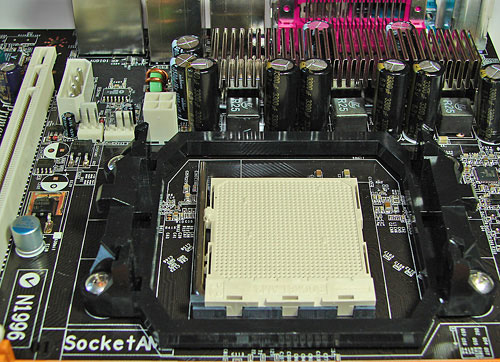 |
| Click to enlarge |
The CPU socket area had plenty of room for our Zalman CNPS9500 AM2 cooler. There should also be plenty of room for alternative cooling solutions. Units similar in size to the Zalman or even larger size cooling solutions should fit in this area without issue.
MSI places the four-pin 12v auxiliary power connector at the top left are of the CPU socket and out of the way of our cooling solutions. However, this connector is located in a position that can hamper airflow with cabling that crosses directly over the CPU heatsink/fan.
The four-pin Molex power connector is located to the right of the first X16 PCI-E connector and must be utilized for multi-GPU or SLI operation. This connector is located in a position that could hamper airflow with cabling that crosses directly over the CPU heatsink/fan. The CPU fan and Chassis fan headers are located between the two power connectors.

The rear panel contains the standard PS/2 mouse and keyboard ports, parallel port, dual LAN ports, and 4 USB ports. Each LAN (RJ-45) port has two LED indicators representing Activity and Speed of the connection. The audio panel consists of 5 ports that can be configured for 2, 4, 6, and 8-channel audio connections. The panel also consists of two S/PDIF (optical/coaxial) ports and an IEEE-1394a port.










17 Comments
View All Comments
Puddleglum - Thursday, June 8, 2006 - link
First comes AMD, then comes Intel. You must wait. Are you opposed to the 965/975x?Conroe comes out in about a month, so I'm sure you'll be seeing massive amounts of reviews in the coming weeks/days.
Myrandex - Thursday, June 8, 2006 - link
I don't know if it is just me, but it looks like in the graphical layout of the 570 that it says 16x connection to the first video card than an 8x connection to the second. I think it should have 16x / SLI (8x) or something on it.Jason
Myrandex - Thursday, June 8, 2006 - link
Also the following needs changed:The Realtek ALC-883 codec offers competitive CPU utilization rates when compared to the Realtek ALC-882 on the Asus board.
I think the Asus needs to be changed to Biostar.
JarredWalton - Thursday, June 8, 2006 - link
Asus changed to Biostar. As for the nF570 graphic, the X16 is because if you use a single GPU, you can get all 16 lanes, but if you use two GPUs, both will get 8 lanes. Yeah, it could be done better, but that image is direct from NVIDIA.Regards,
Jarred Walton
Editor
AnandTech.com
shortylickens - Thursday, June 8, 2006 - link
They jusy had to add two more digits, didnt they?Couldnt call it the Nforce 55, 57 and 59. Are they trying to compete on names again? Must need that extra digit I guess.
Before long we'll have Radeon XXXYYYZZZ9700 Thousand Million Pro Uber Leet Haxor and then we'll see GeForce 999 FXZ 88000 Ultra Grand Prix GT XML.
Then someone will get the idea to simplify the naming system and the whole mess starts over.
Visual - Friday, June 9, 2006 - link
Does the XML model also offer XSLT hardware acceleration? That'd rock, explorer is so slow on it...But I think I'll hold up for now till I can get the Turbo-Diesel Injection models.
Schizzlefuzz - Thursday, June 8, 2006 - link
I've only used Biostar for budget builds before, using DFI and Asus for performance builds, but the TForce 590 SLI Deluxe might be added when I start building AM2 systems for customers.